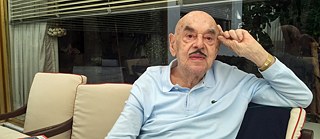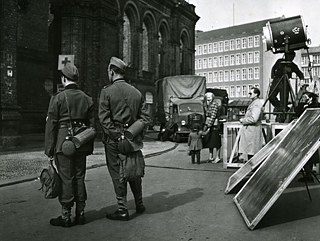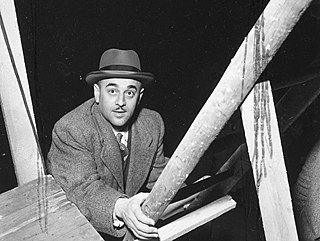Artur Brauner
Films to Stop People Forgetting

Artur Brauner was a legendary German producer. Nobody else shaped German post-war cinema quite like he did, and he did it above all with light entertainment. However, since 1947 Brauner also delved into the Nazi era. Now he has died.
When CCC film studios in the Berlin district of Spandau celebrated their 70th anniversary in September 2016, their then 98-year-old founder, Artur “Atze” Brauner, had every reason to look back proudly. Not just because no other active film production company in Germany has such a long history. It is also primarily to the merit of this indefatigable filmmaker that the National Socialist dictatorship was dealt with as one of German cinema’s central concerns. Almost one in every ten of the approximately 260 films produced by CCC were devoted to this topic – a topic which is a very personal one for Brauner. He was born in Lodz in Poland, in 1918, as the son of a middle-class Jewish family and he himself was subjected to persecution by the National Socialists during the Second World War. Many of his relatives fell victim to the Nazi’s mass murdering of Jews.
“Morituri” – a cinematic monument to the dead
Nevertheless, after the war Brauner still saw his future in Germany. When, on September 19th, 1946, after a dogged struggle with the allied military authorities, he obtained all the necessary licenses, he founded the Central Cinema Company, or CCC, in the US sector of Berlin and set about tackling a remarkable challenge. The problem was that German cinema, so abused by the Nazis as a propaganda weapon, lay morally in ruins equally as much as the country itself – most of the studios had been destroyed. Brauner, however, proved he was a man of entrepreneurial flair and courage. After earning some money with his first CCC production, Herzkönig (Knave of Hearts/ Helmut Weiss, 1947), a light comedy, he started in 1947 with the production of Morituri (Eugen York), a semi-autobiographical drama about a group of prisoners who, after escaping from a concentration camp, fight for survival.
In a country, however, which had just declared the end of the war to be the “Stunde Null” (Zero Hour), the new beginning, hardly any cinemagoers wanted to be confronted with the recent past. Morituri was rejected by audiences. There were even riots. “There I was - stuck with a film, a lot of debt and no money”, Brauner recalls later. “After that we turned above all to comedies, the people wanted to laugh. And with the profits from these films, I paid the debts I incurred with Morituri. And then I said to myself – now I know how it all works, I'll just carry on doing it like that.”
Star contracts written on napkins
When in the 1950s cinema in Germany started booming, CCC enjoyed its heyday with melodramas and comedies, adventure films and musicals. Atze Brauner became the “Economic Miracle Man” of German cinema. He decided to expand, in 1949 he had the site of a former poisonous gas factory in Berlin-Spandau converted into modern film studios. It was there that German stars like Romy Schneider, Heinz Rühmann, Sonja Ziemann or O.W. Fisher went in front of the cameras. In 1958, CCC produced 19 films and Brauner became Europe's most successful independent producer. The magazine Der Spiegel even devoted a cover story to him. The journalists seemed to be fascinated by the energetic movie mogul, who was always dressed in an elegant three-piece suit. “It often took Brauner only two minutes of thought and then make a decision on a 1.2-million-deutschmark film and his projects, star contracts and calculations were often scrawled on a paper napkin between an entrecôte steak and Poire Belle Helene in some hotel dining room.”
Commerce finances art
Now Brauner’s success enabled him to make use of material that was not so “popular”. For example, he was able to win over Jewish returned emigrant, Robert Siodmak, to direct the Gerhart Hauptmann film Die Ratten (The Rats / 1955). The drama about a pregnant young Polish woman in post-war Berlin with Maria Schell in the leading role was awarded a Golden Bear at the Berlin International Film Festival. Nevertheless Brauner was still viewed as a producer of easily digestible films for the masses.
In the 1960s, when the popularity of cinema started to wane and the demands for a renewal of the German film scene grew loud, film critic, Joe Hembus, argued that Brauner was one of those producers who was not so much interested in the survival of the film industry, but only in how much money could be made. In the following years Brauner was, in fact, somewhat eclipsed by the emerging New German film. Instead of using innovative cinema, he encountered the crisis with antiquated epics, Karl May Westerns and Edgar Wallace crime thrillers and even jumped on the sex film bandwagon at some point. He also tried to keep the studios going with TV productions. In 1965, however, he had to make most of his staff redundant. From 1972 to 1980 CCC only produced about ten films.
The Jewish Cycle
In the 1980s and 1990s Brauner concentrated entirely on his “Jewish Cycle”. Die Spaziergängerin von Sans-Souci (The Passer-by, Jacques Rouffio, 1982), Romy Schneider's last film, is part of the cycle, along with Eine Liebe in Deutschland (A Love in Germany, Andrzej Wajda, 1983). In Blutiger Schnee (i.e. Bloody Snow, Jerzy Hoffman, 1984) Brauner's daughter Sharon plays the Jewish girl Ruth, who escapes a Nazi murder squad by a hair’s breadth. These ambitious films were not money spinners either, but they brought Brauner the recognition from the critics that was missing for so long. His best-known film Hitlerjunge Salomon (Europa Europa, Agnieszka Holland, 1990) was awarded a Golden Globe, the screenplay for Hanussen (Hanussen: Hitler’s Astrologer, István Szabó, 1988) nominated for an Oscar. After the turn of the millennium Brauner continued his cycle with films like Babij Jar (Jeff Kanew, 2003).
Despite all the commercial productions – the cinematic remembrance of the Holocaust remains his mission in life. Of course, says Brauner in retrospect that, in the face of financial losses, he had often thought it might be better to steer clear of such material. “But I know, after I am gone, there will be nobody around to make such films.” Artur Brauner, however, did not need to be that pessimistic. Since 2006, his daughter Alice has been managing the CCC business. And with films like Wunderkinder (Child Prodigies, Markus Rosenmüller, 2011) and Auf das Leben! (To Life!, Uwe Jansen, 2014) she is following in her father’s footsteps.
Arthur Brauner died on 7 July 2019 at the age of 100.
Artur Brauner has made his films about the Holocaust available to the Goethe-Institut for cultural relations work abroad. The films are also to be found at the Jewish Museum Berlin, as well as at the Visual Center of the Yad Vashem memorial site in Jerusalem.














